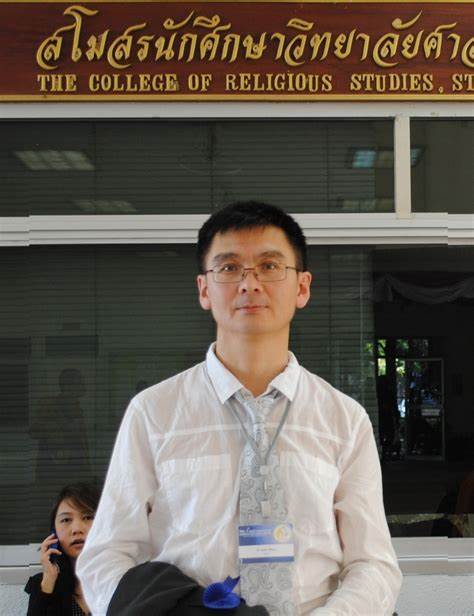

Russian Buddhist scholar Dr. Baatr Kitinov
Dr. Baatr Kitinov is a native Buddhist of the Russian Federation, from the Kalmyk Region, an autonomous region of the Russian Federation. He is currently a Leading Research Fellow of Institute of Oriental Studies, Russian Academy of Sciences, Moscow. Recently in Delhi to attend the Global Buddhist Summit, he spoke to Aditi Bhaduri about the Buddhist community in the Russian Federation; how Buddhism travelled to Russia from India via Mongolia and China; how through the long turbulent centuries of war and imperialism, the Buddhists held on to their faith, and the current status of the Buddhist community in Russia today.
Excerpts from the interview:
IN: When and how did Buddhism first travel to Russia?
BK: Buddhism first appeared in the Russian Far East from China, through Mongolia. It was Chinese Buddhism, and it was in the eighth century AD. Buddhism came to Russia in three waves. The second wave appeared in the beginning of the 15th century. This was also a form of Chinese Buddhism with some Tibetan characteristics. The third and last wave occurred at the end of the 16th century and this was Tibetan Buddhism.
It was the Kalmyks who first moved to the territory of the Russian Federation from South Siberia, to the Caspian Sea (Astrakhan) due to many reasons. In fact, “Kalmak” is a Turkic term. We call ourselves “Oirats”. Kalmyks became Buddhists sometime in the middle of the 13th century AD. Till then they were Shamanists and partly Christians. In the middle of the 15th century the Geluk branch of Tibetan Buddhism – the Yellow Hats – arrived in the region and the Kalmyks adopted this branch of Buddhism. In fact, it was the Kalmyks who [helped to] established the power of the Dalai Lama over the Tibetan Buddhists – in 1652 with the fifth Dalai Lama.
In the second half of the 18th century AD the people in the Buryat Region became Buddhists. People in Tuva already had Buddhist temples in the 13th century, perhaps these were Uighur temples. They became followers of the Yellow Hat teaching when they became part of the Jungar Khanate.
IN: How big is the Buddhist community in Russia today?
BK: Russia today is home to approximately one million Buddhists. The Buryat Autonomous Republic has around 400,000 Buddhists, Kalmykia has 135, 000 Buddhists, the Republic of Tuva has 100,000, and the rest are Russian converts mostly.
IN: How was Buddhism preserved over the centuries in this region, so far away from its birthplace?
BK: There is no simple answer. The people of Buryatia and Tuva lived far away from the European part of Russia. The Kalmyks, on the other hand, faced many wars. So it was difficult for them to keep the faith. Yet, they did, in the face of tremendous odds. Their loyalty to the Dalai Lama played a significant role. Their belief in their faith – in karma – played another major role. We believed that everything is karma, and if we were to keep the faith, it would keep our karma clean.
IN: How would you describe the relations between Russia’s Buddhist community and the Russian Orthodox Church?
BK: Relations between the Buddhists and the [Russian Orthodox] Church are currently good. Buddhists are recognised as an official minority. However, under the Russian Tsarist Empire, they tried sometimes to convert “pagans” to Christianity as that was the state policy then. However, towards the end of Tsarist rule, there appeared a wave of Indophiles, especially those interested in Buddhism like Alexander Scherbatsky, and that was helpful for us. During the USSR, all religions were suppressed, not just Buddhists alone.
In the Russian Federation, state and religion are separate. So we do not feel any pressure, there is freedom for us, but we have other issues. We are a weak and economically backward community. So we find it difficult sometimes to preserve our identity. For instance, the state donates land to us for a temple but we are unable to find the resources to build it. We need state patronage.
However, Buddhist teachings are really attractive for many in Russia today. Buddhist studies are developing in Russia today.
IN: Can India do anything for the Buddhist community in Russia?
BK: India can support Buddhists and Buddhism in Russia in various ways. They can send Pali and Sanskrit teachers and train such teachers amongst us. They can promote museum exhibitions, etc.
Also read: China trying to destroy Buddhism but the religion stands tall, says Dalai Lama
NATO's recent decision to ramp up military spending will not significantly impact Russia's security, Foreign…
India has imposed anti-dumping duties on imports of Plastic Processing Machines from China and Taiwan,…
The Human Rights Desk of the Department of Information and International Relations for the Central…
India's trade delegation is currently in the United States for high-stakes negotiations aimed at finalising…
Defence Minister Rajnath Singh held a meeting with his Russian counterpart Andrey Belousov on the…
Hailing the all-party delegation which travelled to 33 different countries as part of India's global…